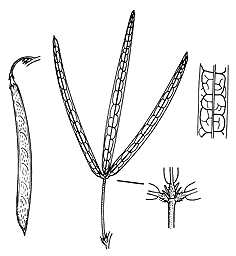Glycine clandestina J.C.Wendl. APNI* Synonyms: Glycine sp. A sensu Tindale (1991) APNI*

Description: Twiner, stems non-stoloniferous; hairy with retrorse, white, grey or dark rusty, soft hairs.
Leaves palmately 3-foliolate, dimorphic; leaflets of upper leaves linear to ± narrow-elliptic or oblong-lanceolate, 1–8 cm long, 2–10 mm wide, apex obtuse or acute; leaflets of lower leaves (and often in the subalpine plants) oblanceolate to broad-obovate or ± circular, 0.5–3.0 cm long, 2–8 mm wide; upper surface sparsely hairy to ± glabrous; lower surface with appressed or spreading hairs; stipels absent on median petiolule.
Racemes 4–18-flowered, 1–3.5 times as long as leaves. Calyx finely pubescent or strigose, 3 lower teeth from two-thirds to equalling the tube. Standard 5–10 mm long, ± mauve to rose-purple or white.
Pod straight, 1.2–5.3 cm long, 2.5–4 mm wide, without purple flecks, sparsely hairy to glabrous; seeds 4–12.
Flowering: all year.
Distribution and occurrence: Widespread from coast to subalpine situations.
NSW subdivisions: NC, CC, SC, NT, CT, ST, NWS, CWS, SWS, NWP, SWP, NFWP
Other Australian states: Qld Vic. Tas. S.A.
The leaflet shape and pubescence are extremely variable; however, it is not possible to formally separate these entities due to the number of intermediates between them.
Text by B.E. Pfeil & M.D. Tindale
Taxon concept: M.D. Tindale (1986)
APNI* Provides a link to the Australian Plant Name Index (hosted by the Australian National Botanic Gardens) for comprehensive bibliographic data
***The AVH map option provides a detailed interactive Australia wide distribution map drawn from collections held by all major Australian herbaria participating in the Australian Virtual Herbarium project.
|


